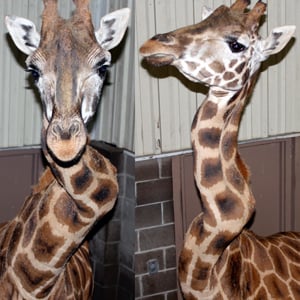Giraffe Dies in Tulsa Zoo
Last month, Amali, a 5-year-old giraffe, got an unnatural knot in her neck from an injury sustained in-transit to the Tulsa Zoo, where she was expected to breed with a male giraffe. After weeks of treatment with ineffective drugs, Amali’s neck remained crooked. A few days ago, zoo veterinarians prepared her for an X-ray procedure, but soon after sedation, Amali died.
Amali’s disability may have looked unusual, but her tragic passing is an all-too-ordinary occurrence for giraffes at zoos. Captive giraffes frequently die as a result of inadequate care and space. Veterinary neglect is often lethal—as it was in 2005 for a giraffe named Kenya at the Columbus Zoo after the zoo’s chief veterinarian administered the wrong drug during surgery. In 2006, Makena, a 1-year-old giraffe, fatally broke her neck while she struggled to free herself after her head became wedged in a small space at the Lee Richardson Zoo in Kansas. Earlier last year, Dusti died from strangulation when he became entangled in a pulley system at Brookfield Zoo in Illinois. The year before, Makonnen, a 2-year-old giraffe, died in a barn fire at Six Flags in Vallejo, Cali.
Giraffes belong in the wild, not in enclosures that offer many opportunities for these curious animals to become injured. If you notice abuse or mistreatment of animals in your local zoo, file a report. Your observations and documentation can save lives that would otherwise be lost to neglect and carelessness.
Written by Logan Scherer


